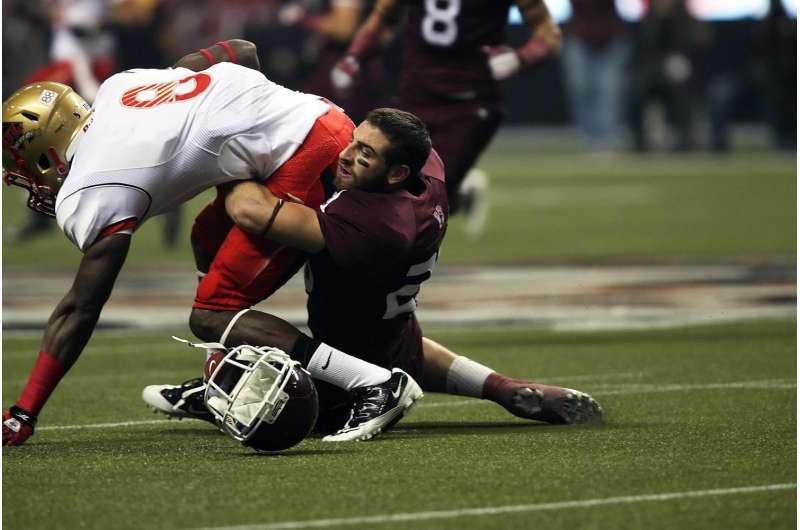Three ways neuroscience can advance the concussion debate

While concussion awareness has improved over the past decade, understanding the nuances of these sports injuries, their severity, symptoms, and treatment, is still a work in progress. In the June 21 issue of Neuron, UCLA neurologists and neurotraumatologists review the science of concussions and outline several areas where neuroscience and clinical research can help create consensus in the field: definitions of what acute and chronic concussions are, diagnostics, and management and treatment.
"For patients, you have to be able to provide the best care even if you don't have the exact research study to prove what you're doing, and you also have to address the information that the patients and their families are getting through the media," says Christopher C. Giza (@griz1), Director of the UCLA Steve Tisch BrainSPORT program and Professor of Pediatrics, Neurology, and Neurosurgery at the University of California Los Angeles. "That's a discussion that's hard to have because people naturally look for very short answers and sound biytes, and it's far more complex than that."
1. Let's Agree on the Definition of a "Concussion," both Acute and Chronic
The Centers for Disease Control and Prevention reported about 2.8 million traumatic-brain-injury-related emergency department visits, hospitalizations, and deaths in the United States in 2013. However, researchers disagree about whether all concussions and traumatic brain injuries are equal. A concussion may be characterized by wooziness, disorientation, incoordination, headache, and other "typical" symptoms after a hit to the head and may occur even with only rapid back-and-forth motion of the head and neck. Some have postulated that subconcussive injuries with repetitive head impacts in the absence of symptoms may result in cumulative problems.
Giza says that although a concussion and a more severe traumatic brain injury may sound similar, and although they may share some symptoms, the overlap between the two is not clear. Additionally, the determination of whether someone has a concussion or a mild traumatic brain injury or something else is largely subjective and often relies heavily on symptom reporting from the patient.
"One of the things that will help us on the acute diagnosis of concussion would be if we moved away from the current understanding of concussion as a black-or-white, yes-or-no answer," Giza says. "There are scenarios when we can be more certain, clinically, that we're making the correct diagnosis. If there's a clear impact event, there's a typical constellation of symptoms that occurs in temporal relationship to the impact, and that symptom pattern has a time course consistent with what we see in concussion in terms of peaking early followed by gradual improvement, then we can diagnose confidently."
Giza notes that not every symptom that occurs after a hit to the head is related to a concussion, which is why formal diagnosis requires an experienced clinician. Similarly, not all chronic symptoms are referable to a distant concussion or head impact. Understanding the physiological mechanisms underlying concussions and concussive symptoms (both acute and chronic) can lead to better diagnostic tests and potentially point the way to individualized treatment plans.
2. Realize that Diagnosis Is Critical to Treatment
Some concussion patients experience atypical symptoms, or usual symptoms that get worse later on instead of improving. One potential pitfall of concussion diagnosis is that some symptoms may appear to be concussion related but could actually be a symptom of something else, like migraine, dehydration, hyperthermia, neck strain, or more severe brain injury.
"We need to prioritize what we think sounds like a definite concussion vs. probable vs. possible, and even recognize that there are syndromes with neurological symptoms that occur after impact that are something more than a concussion," Giza says. "There are rare patients who have cerebral edema—sometimes, we call it second impact syndrome, which is another ambiguous term—but that's not a concussion. Patients who very rarely get a subdural hematoma as a consequence of a sports injury sometimes are portrayed as having had a concussion, but a subdural hematoma or an epidural hematoma is something much more than what we would diagnose clinically as a concussion."
There are also computerized tests, and soon, hopefully blood tests, brain imaging, and electrical tests that can help diagnose concussion or follow recovery, but because concussions are "the most complex injury to the most complex organ" in the human body, there is not necessarily a magic bullet, catch-all, perfect method for diagnosing concussions.
3. Focus on Animal Research to Discover Better Treatment Plans
"In the clinical concussion world, many of the research protocols are observational, but I think laboratory neuroscience can inform in terms of how important is the time between injuries and how much cognitive or physical activity should there be during the recovery period," Giza says. Focusing on animal models is one way neuroscience can help accelerate concussion and traumatic brain injury research, particularly in the investigation of how consequences of repetitive injury differ when they occur very close in time versus when they are spaced out, and in determining when the brain is physiologically ready to return to activity.
"Animal models are also well suited for looking at long-term processes set into play by the acute injury." Giza says. "So animals can be subjected to repetitive injuries when they're relatively young—at least in rodent models, within a year or two, those animals become 'old' animals, and we can look to see along that time course whether mechanisms of neurodegeneration have been activated, and whether that leads to deficits over time. Those studies can be done in the time course of months to years rather than decades, as would be necessary for clinical studies. If we do things right in the coming years, we can really change the game in our understanding about concussion and brain injuries."
More information: Neuron, Giza et al: "It's Not All Fun & Games: Sports, Concussions and Neuroscience" www.cell.com/neuron/fulltext/S0896-6273(17)30404-X , DOI: 10.1016/j.neuron.2017.05.003


















